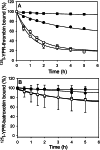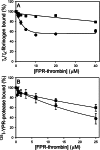Batroxobin binds fibrin with higher affinity and promotes clot expansion to a greater extent than thrombin
- PMID: 23612970
- PMCID: PMC3675619
- DOI: 10.1074/jbc.M113.464750
Batroxobin binds fibrin with higher affinity and promotes clot expansion to a greater extent than thrombin
Abstract
Batroxobin is a thrombin-like serine protease from the venom of Bothrops atrox moojeni that clots fibrinogen. In contrast to thrombin, which releases fibrinopeptide A and B from the NH2-terminal domains of the Aα- and Bβ-chains of fibrinogen, respectively, batroxobin only releases fibrinopeptide A. Because the mechanism responsible for these differences is unknown, we compared the interactions of batroxobin and thrombin with the predominant γA/γA isoform of fibrin(ogen) and the γA/γ' variant with an extended γ-chain. Thrombin binds to the γ'-chain and forms a higher affinity interaction with γA/γ'-fibrin(ogen) than γA/γA-fibrin(ogen). In contrast, batroxobin binds both fibrin(ogen) isoforms with similar high affinity (Kd values of about 0.5 μM) even though it does not interact with the γ'-chain. The batroxobin-binding sites on fibrin(ogen) only partially overlap with those of thrombin because thrombin attenuates, but does not abrogate, the interaction of γA/γA-fibrinogen with batroxobin. Furthermore, although both thrombin and batroxobin bind to the central E-region of fibrinogen with a Kd value of 2-5 μM, the α(17-51) and Bβ(1-42) regions bind thrombin but not batroxobin. Once bound to fibrin, the capacity of batroxobin to promote fibrin accretion is 18-fold greater than that of thrombin, a finding that may explain the microvascular thrombosis that complicates envenomation by B. atrox moojeni. Therefore, batroxobin binds fibrin(ogen) in a manner distinct from thrombin, which may contribute to its higher affinity interaction, selective fibrinopeptide A release, and prothrombotic properties.
Keywords: Batroxobin; Blood Coagulation Factors; Fibrin; Fibrinogen; Fibrinopeptides; Snake Venom; Thrombin.
Figures








Similar articles
-
The fibrinogen γA/γ' isoform does not promote acute arterial thrombosis in mice.J Thromb Haemost. 2014 May;12(5):680-9. doi: 10.1111/jth.12534. J Thromb Haemost. 2014. PMID: 24916154 Free PMC article.
-
Evidence that both exosites on thrombin participate in its high affinity interaction with fibrin.J Biol Chem. 2003 Jun 13;278(24):21584-91. doi: 10.1074/jbc.M300545200. Epub 2003 Apr 7. J Biol Chem. 2003. PMID: 12682049
-
Fibrinogen gamma-chain splice variant gamma' alters fibrin formation and structure.Blood. 2003 Jul 15;102(2):535-40. doi: 10.1182/blood-2002-10-3150. Epub 2003 Mar 27. Blood. 2003. PMID: 12663453
-
Antithrombin I. Inhibition of thrombin generation in plasma by fibrin formation.Thromb Haemost. 2003 Jan;89(1):9-12. Thromb Haemost. 2003. PMID: 12540947 Review.
-
The structure and biological features of fibrinogen and fibrin.Ann N Y Acad Sci. 2001;936:11-30. doi: 10.1111/j.1749-6632.2001.tb03491.x. Ann N Y Acad Sci. 2001. PMID: 11460466 Review.
Cited by
-
Exploring the Diversity and Function of Serine Proteases in Toxicofera Reptile Venoms: A Comprehensive Overview.Toxins (Basel). 2024 Oct 3;16(10):428. doi: 10.3390/toxins16100428. Toxins (Basel). 2024. PMID: 39453204 Free PMC article. Review.
-
Mathematical modeling to understand the role of bivalent thrombin-fibrin binding during polymerization.PLoS Comput Biol. 2022 Sep 15;18(9):e1010414. doi: 10.1371/journal.pcbi.1010414. eCollection 2022 Sep. PLoS Comput Biol. 2022. PMID: 36107837 Free PMC article.
-
Slounase, a Batroxobin Containing Activated Factor X Effectively Enhances Hemostatic Clot Formation and Reducing Bleeding in Hypocoagulant Conditions in Mice.Clin Appl Thromb Hemost. 2021 Jan-Dec;27:10760296211018510. doi: 10.1177/10760296211018510. Clin Appl Thromb Hemost. 2021. PMID: 34047195 Free PMC article.
-
The plasma fibrinogen levels in the nitroglycerin-induced chronic migraine rat model and its association between migraine-associated vestibular dysfunction.Front Neurol. 2023 Mar 24;14:980543. doi: 10.3389/fneur.2023.980543. eCollection 2023. Front Neurol. 2023. PMID: 37034073 Free PMC article.
-
Preliminary assessment of Hedychium coronarium essential oil on fibrinogenolytic and coagulant activity induced by Bothrops and Lachesis snake venoms.J Venom Anim Toxins Incl Trop Dis. 2014 Sep 1;20:39. doi: 10.1186/1678-9199-20-39. eCollection 2014. J Venom Anim Toxins Incl Trop Dis. 2014. PMID: 26413083 Free PMC article.
References
-
- Wolberg A. S. (2012) Determinants of fibrin formation, structure, and function. Curr. Opin. Hematol. 19, 349–356 - PubMed
-
- Mosesson M. W. (2005) Fibrinogen and fibrin structure and functions. J. Thromb. Haemost. 3, 1894–1904 - PubMed
-
- Chung D. W., Davie E. W. (1984) γ and γ′ chains of human fibrinogen are produced by alternative mRNA processing. Biochemistry 23, 4232–4236 - PubMed
-
- Fornace A. J., Jr., Cummings D. E., Comeau C. M., Kant J. A., Crabtree G. R. (1984) Structure of the human γ-fibrinogen gene. Alternate mRNA splicing near the 3′ end of the gene produces γA and γB forms of γ-fibrinogen. J. Biol. Chem. 259, 12826–12830 - PubMed
Publication types
MeSH terms
Substances
Grants and funding
LinkOut - more resources
Full Text Sources
Other Literature Sources

